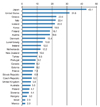Current status and policy options for high-tech medical devices in Korea: vertical and horizontal synchronization of health policy
Article information
Abstract
This paper examines current status of high-tech medical devices in Korea, especially bringing focus to the computed tomography and magnetic resonance imaging, and traces government policies relevant to this situation. The rapid diffusion of high-tech medical devices mainly led by physician's clinics and small hospitals and lack of efficient policy coordination and synchronization have resulted deterioration of quality and decrease of social benefit. The quality problem could be resolved when the pursuit of micro-efficiencies by the providers are synchronized to the macro-efficiency of health system. If the government disclose quality information of high-tech devices and gives incentives to the provider's efforts to increase quality, the current competition between providers to capture patients could be evolved to the competition for better quality. In addition to this vertical synchronization, horizontal policy synchronizations such as with health insurance policy are also discussed.








